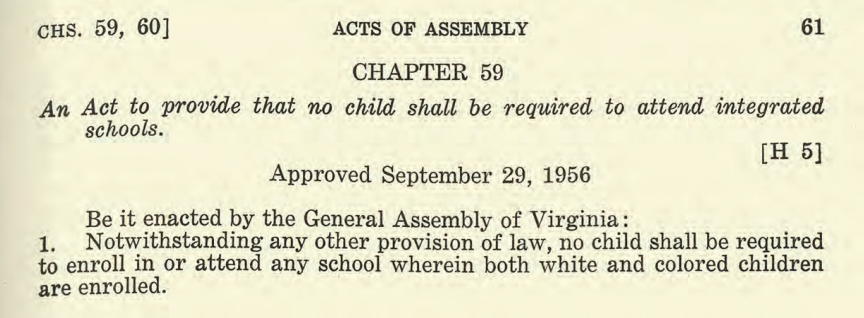 the General Assembly and the Byrd Organization used a strategy of Massive Resistance in an attempt to perpetuate segregation in Virginia
the General Assembly and the Byrd Organization used a strategy of Massive Resistance in an attempt to perpetuate segregation in VirginiaSource: Commission to Examine Racial Inequity in Virginia Law (November 15, 2019)
 the General Assembly and the Byrd Organization used a strategy of Massive Resistance in an attempt to perpetuate segregation in Virginia
the General Assembly and the Byrd Organization used a strategy of Massive Resistance in an attempt to perpetuate segregation in Virginia
Source: Commission to Examine Racial Inequity in Virginia Law (November 15, 2019)
White English colonists created a new society in Virginia, starting in 1607. They displaced the 25,000 or so Native Americans who lived on the 40,000 square miles that were, after 1863, the boundaries of the state. The colonists also imported blacks from Africa and the Caribbean and created a new form of law that kept them as enslaved workers. After the Civil War ended that practice formally in 1865, the dominant white culture suppressed efforts of the black citizens to achieve economic and social equality.
When Virginia established a public school system in 1870, it segregated whites into one set of schools and blacks into another. The Native Americans who had survived within Virginia struggled to maintain their unique third identity, rather than be categorized as "colored."
Formal segregation laws and a "Jim Crow" society were threatened by Federal courts in the 1900's. A carefully planned series of lawsuits led by the National Association for the Advancement of Colored People (NAACP) challenged the implementation of "separate but equal" public services which the US Supreme Court had permitted in its 1896 Plessy v. Ferguson decision.
Laws establishing a segregated society in Virginia were invalidated by Federal judges. The 1946 Morgan v. Commonwealth of Virginia decision by the US Supreme Court blocked enforcement of laws segregating interstate transportation in 1946, but it was the Brown v. Board of Education decision requiring desegregation of schools which triggered Massive Resistance.1
Virginia literally closed its schools to prevent integration. On February 3, 1959, Arlington County re-opened Stratford Junior High.2
That same semester, schools in Charlottesville, Front Royal, and Norfolk re-opened as well. Two supreme courts, at both the state and Federal levels, had ruled the school closings to be unconstitutional. Governor Almond had considered refusing to comply, and the leaders of Prince Edward County did proceed to close all of the public schools in a last-ditch effort to block desegregation, but Massive Resistance died a very public death in early 1959.
Massive Resistance was not a viable legal or political strategy, but the Byrd Organization which controlled Virginia politics recognized the threat to its power. That political machine relied upon voter disfranchisement and suppression, as well as gerrymandering, to ensure rural whites dominated state government. The Massive Resistance effort morphed in the 1960's into overt and covert racist appeals to voters, based on an assumption that whites were more concerned about racial dominance than other issues.
The Ku Klux Klan reorganized in the state. When leaders in both the Republican and Democratic parties refused to endorse them, third party candidates appealed for their votes. William J. Story ran for governor in 1965 on the Conservative Party ticket and got 13% of the votes. George Lincoln Rockwell, founder and leader of the American Nazi Party, ran as an Independent and received 1% of the votes.3
In 2017, a rally and march through the University of Virginia "grounds" (campus) in Charlottesville by white supremacists led to the death of a counter-protestor and two members of the State Police, when their helicopter crashed. National attention was focused on the incident, and why systemic racism remained such a powerful element in American society.
White Power leaders recognized that the hegemony of their race was crumbling, as demographics changed and white Caucasians lost their status as the majority of the population in Virginia and the rest of the United States. Their emotional responses reflected the inability of the leaders of Massive Resistance in the 1950's to adjust to a diverse society:4
Source: Virginia Public Media (VPM), Locked Out: The Fall Of Massive Resistance